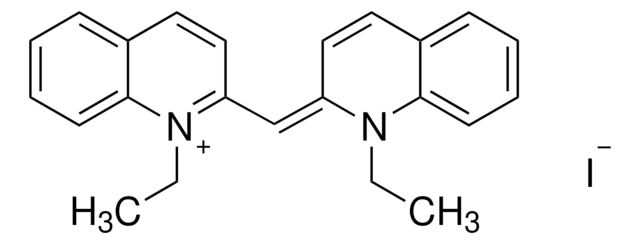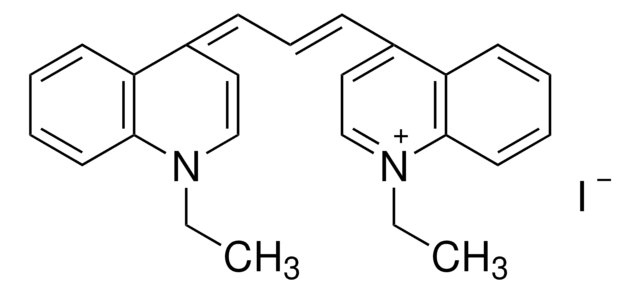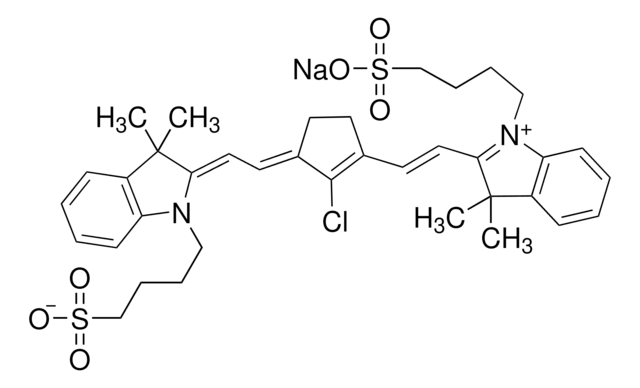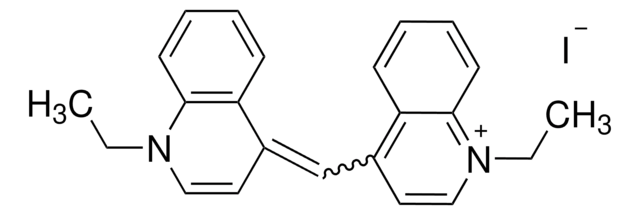173738
3,3′-Diethylthiacarbocyaniniodid
Dye content 95 %
Synonym(e):
3-Ethyl-2-(3-[3-ethyl-2(3H)benzothiazolyliden]-1-propenyl)-benzothiazoliumiodid, DiSC2(3)
About This Item
Empfohlene Produkte
Form
solid
Qualitätsniveau
Zusammensetzung
Dye content, 95%
mp (Schmelzpunkt)
268-270 °C (dec.) (lit.)
λmax
560 nm
SMILES String
[I-].CCN1\C(Sc2ccccc12)=C\C=C\c3sc4ccccc4[n+]3CC
InChI
1S/C21H21N2S2.HI/c1-3-22-16-10-5-7-12-18(16)24-20(22)14-9-15-21-23(4-2)17-11-6-8-13-19(17)25-21;/h5-15H,3-4H2,1-2H3;1H/q+1;/p-1
InChIKey
VZBILKJHDPEENF-UHFFFAOYSA-M
Suchen Sie nach ähnlichen Produkten? Aufrufen Leitfaden zum Produktvergleich
Allgemeine Beschreibung
Anwendung
Signalwort
Warning
H-Sätze
Gefahreneinstufungen
Eye Irrit. 2 - Skin Irrit. 2 - STOT SE 3
Zielorgane
Respiratory system
Lagerklassenschlüssel
11 - Combustible Solids
WGK
WGK 3
Flammpunkt (°F)
Not applicable
Flammpunkt (°C)
Not applicable
Persönliche Schutzausrüstung
dust mask type N95 (US), Eyeshields, Gloves
Hier finden Sie alle aktuellen Versionen:
Analysenzertifikate (COA)
Die passende Version wird nicht angezeigt?
Wenn Sie eine bestimmte Version benötigen, können Sie anhand der Lot- oder Chargennummer nach einem spezifischen Zertifikat suchen.
Besitzen Sie dieses Produkt bereits?
In der Dokumentenbibliothek finden Sie die Dokumentation zu den Produkten, die Sie kürzlich erworben haben.
Artikel
Developed in the last several years, fluorescence quenching microscopy (FQM) has enabled rapid, inexpensive, and high-fidelity visualization of two-dimensional (2D) materials such as graphene-based sheets and MoS2.
Graphene has emerged as the new wonder material. Being only one atom thick and composed of carbon atoms arranged in a hexagonal honeycomb lattice structure, the interest in this material has exploded exponentially since 2004 when it was first isolated and identified using a very simple method.
Unser Team von Wissenschaftlern verfügt über Erfahrung in allen Forschungsbereichen einschließlich Life Science, Materialwissenschaften, chemischer Synthese, Chromatographie, Analytik und vielen mehr..
Setzen Sie sich mit dem technischen Dienst in Verbindung.









